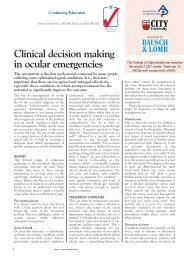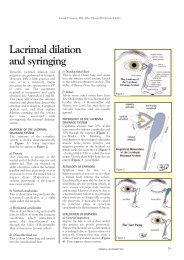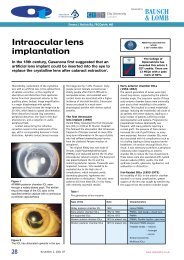April 2011: C-15873 Paediatric Optometry Part 1
April 2011: C-15873 Paediatric Optometry Part 1
April 2011: C-15873 Paediatric Optometry Part 1
Create successful ePaper yourself
Turn your PDF publications into a flip-book with our unique Google optimized e-Paper software.
8. Which one of the following is an advantage of the chart design shown in PANEL I of Image C?<br />
a. The spacing of the optotypes and the lines follows a geometric progression<br />
b. The same number of optotypes are presented on each line<br />
c. There are equal crowding affects on each of the lines of acuity<br />
d. All the above<br />
The correct answer is D. Panel I shows a Bailey-Lovie design of letter chart. 6 Compared with<br />
Snellen charts, the Bailey-Lovie design has several important advantages including the letter size<br />
and inter-letter and inter-line spacing progress logarithmically from one line to the next and the<br />
same number of optotypes are presented on each line. These features mean that there are similar<br />
crowding effects and task difficulty on each line.<br />
9. Which one of the following differences in chart design between the charts shown in PANEL I of<br />
Image C and PANEL II of Image C is TRUE?<br />
a. The optotypes in PANEL I are 5x4 in size whilst the optotypes in PANEL II are 5x5 in<br />
size<br />
b. The optotypes in PANEL I follow a logarithmic progression whilst the optotypes in PANEL<br />
II follow an arithmetic progression<br />
c. The optotypes in PANEL I have less crowding effects than the optotypes in PANEL II<br />
d. The optotypes in PANEL I are suitable for children under the age of 4 years<br />
The correct answer is A. The Bailey-Lovie chart uses letters that are slightly narrower than they are<br />
tall (5x4) whereas the Kay pictures are 5x5 in dimensions, following the Sloan design. The<br />
optotypes in both Panel I and Panel II follow a logarithmic progression and should induce similar<br />
crowding effects although a casual inspection might suggest less inter-optotype spacing in panel I,<br />
which could result in more crowding. It is easier to standardise the legibility of letters than pictures,<br />
although pictures like the Kay ones or the Lea pictures (not show) may be necessary for some<br />
children under the age of 4 years.<br />
IMAGE D:<br />
10. Which one of the following statements about the condition shown in Image D is FALSE?<br />
a. This could be a congenital cataract<br />
b. This could be retinoblastoma<br />
c. This could be bilateral myopia<br />
d. This could be a persistent pupillary hyperplastic vitreous<br />
The correct answer is C. A white pupil (leukocoria) should always be taken seriously, although<br />
sometimes a dilated fundoscopy shows this to be a false alarm. A true white pupil, like that shown<br />
in the image, could have several causes, including congenital cataract, persistent pupillary<br />
hyperplastic vitreous, retinal detachment, or of most concern retinoblastoma. Assuming that the<br />
child is fixating the camera properly, it is not likely to be bilateral myopia.<br />
11. What is the MOST appropriate management for the condition shown in Image D?<br />
a. No management is required, review in 6 months<br />
b. No management is required, review in 1 year<br />
c. Routine referral to ophthalmology is required

















